The St. Louis Arsenal was the primary focus of both sides. It's interesting to note that in the writings of the men who were there in 1861, it was always their side that was poorly armed and it was the opposing side that was well armed. But they were all desperate for the arms and munitions that were stored in the St. Louis Arsenal. [113]
Both the Secessionists and the Unconditional Unionists had established paramilitary organizations but were finding it difficult to provides weapons for their members. The United States government stored a large quantity of arms at the Arsenal in St. Louis. In his book on Nathaniel Lyon and Missouri in 1861, Colonel James Peckham wrote the following about the arsenal: [114]
[At the Arsenal] were stored . . . 60,000 stand of arms, 1,500,000 ball cartridges, several field pieces and siege guns, together with a large amount of machinery in the several shops, and munitions of war in abundance. In the main magazine there were 90,000 pounds of powder.
In his book, Rebellion in Missouri, 1861, Hans Christian Adamson wrote the following description of the St. Louis Arsenal: [115]
In 1861, the Saint Louis Arsenal covered an area of 56 acres in the from of a rough rectangle that ran between Carondelet [now named Broadway] Avenue and the Mississippi River in the southern section of the city. The Arsenal was situated on low and level ground that was faced by hills to the south and southwest. On its three land sides, the area was enclosed by massive limestone walls ten feet high and three feet thick. A substantial fence ran along the river front. … Within the walls were, in addition to workshops, warehouses, foundries, laboratories, powder magazines, and barracks for personnel, four large two-story stone buildings with slate roofs [in which the munitions were kept].
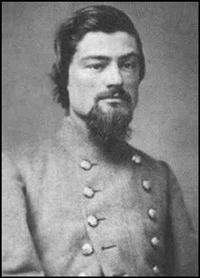
Basil Duke, a leader of the pro-southern St. Louis Minute Men, later described the importance of the Saint Louis Arsenal: [116]
But if the possession of Missouri and the city of Saint Louis was important to ultimate Confederate success, the seizure of the Saint Louis arsenal was a matter of vital and immediate necessity. That arsenal contained sixty thousand stand of small arms, thirty-five or forty pieces of artillery, and a vast store of ammunition and military equipments.
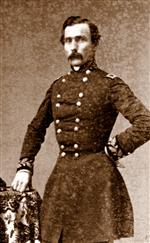
The St. Louis Arsenal was a prize that Governor Claiborne Jackson had been eying as early as January 1861. The Minute Men in St. Louis had asked the Governor for permission to seize the Arsenal, saying they had 1,000 men available. Missouri State Militia Brigadier-General Daniel Frost found this information quite alarming. He felt the Minute Men were hot heads whose actions would cause the Federals to move reinforcements into Saint Louis. On January 24th, Brigadier-General Daniel M. Frost, commander of the State Militia, sent a letter to Jackson describing his meeting with U. S. Major William H. Bell, who was the commanding officer in charge of the arsenal. Frost assured Jackson that Major Bell was sympathetic with their cause and would yield the arsenal to State authorities. [117]
According to Thomas L. Snead, who at the time was the aide-de-camp to Missouri Governor Claiborne Jackson, had this to say about Frost: [118]
No one comprehended more clearly than General Frost the necessity which compelled Missouri to keep the arsenal and its stores within her grasp, if she would arm and equip her people; as arm them she must, sooner or later, whether to fight for the Union, or against it, or to maintain her own neutrality. This necessity he made manifest to the Governor, and was by him authorized to seize the arsenal, whenever the occasion might require such decisive action.
Missouri State Militia Brigadier-General Daniel Frost had visited the St. Louis Arsenal on January 24th to speak with its commander, Major William H. Bell. Bell was a North Carolina native who was sympathetic to the Southern cause. Frost described the results of the meeting to the Governor in a note: [119]
I have just returned from the arsenal . . . I found the Major everything that you or I could desire. He assured me that he considered that Missouri had, whenever the time came, a right to claim it as being on her soil . He asserted his determination to defend it against any and all irresponsible mobs, come from whence they might, but at the same time gave me to understand that he would not attempt any defense against the proper State authorities . . . In a word, the Major is with us, where he ought to be.
This arsenal, if properly looked after, will be everything to our State, and I intend to look after it; very quietly, however.
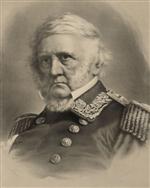
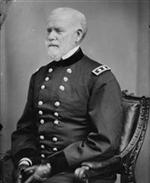
The United States War Department kept hearing rumors of plans to seize the arms at the St. Louis Arsenal. On January 26th, General-in-Chief Winfield Scott, United States Army, had his Adjutant-General sent the following telegram to the US Commander of the Department of the West, Brigadier-General William Harney: [120]
Give particular attention to the safety of the Saint Louis Arsenal, and for that purpose call to the arsenal any part or the whole of the recruits from Jefferson Barracks.
On January 29th, Harney would have a messenger sent to Captain Nathaniel Lyon in command at Fort Scott, Kansas: [121]
Repair forthwith with your command to Saint Louis Arsenal.
Major Bell was removed from command of the Arsenal and replaced by Major Peter V. Hagner, who assumed command on January 24th. When Lyon arrived at the Arsenal, he immediately began to but heads with Hagner. [122]
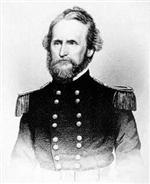
Immediately upon his arrival, Lyon realized just how susceptible the Arsenal was to attack. Lyon felt thwarted by Hagner in his attempts to strengthen the arsenal's defenses. Lyon wrote a note to Frank Blair on February 25th expressing his frustration with Hagner: [123]
Major Hagner refuses to [strengthen the defenses of the arsenal] . . . This is either imbecility or damned villany.
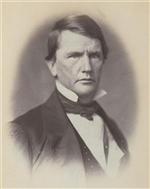
On February 13th, General-in-Chief Winfield Scott sent the following wire to the military commander in the west, Brigadier-General William S. Harney: [124]
Have you in the Saint Louis Arsenal troops enough to defend it? Ought you not to send up all the men from Jefferson Barracks?
Harney continued to downplay the threat which can be seen in his reply on February 19th: [125]
. . . the apprehensions which have been entertained of a demonstration against the Saint Louis Arsenal have not been well founded, and that such an attempt has not been at any time seriously contemplated, it has not appeared to me that the safety of the arsenal required that I should call up any considerable portion of the troops from Jefferson Barracks. Moreover, the secession party is in a decided minority in Saint Louis, and there is every reason to suppose that in the event of a movement from any quarter upon the arsenal its garrison would be promptly succored by an overwhelming force from the city. At any rate such is the prevailing opinion in the community, and in the existence of the sentiment may, it is thought, be found a sufficient warrant for the belief that the arsenal is not at this time in danger. The Saint Louis Arsenal is, however, being put in as complete a defensive condition as possible.
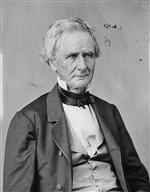
Frank Blair started a campaign to get Major Hagner removed from command. He, of course, wanted him replaced with Captain Nathaniel Lyon. He would write to Secretary of War, Simon Cameron about this. Blair's lobbying was effective for the Secretary of War issued Special Orders No. 74 on March 13th: [126]
Capt. N. Lyon, Second Infantry, the senior officer of the line present and on duty at Saint Louis Arsenal, Mo., is assigned to the command of the troops and defenses at that post.

Everyone's fears were realized on April 12th, when the Confederates initiated open warfare by firing on the Federal garrison at Fort Sumter. Following the fall of Fort Sumter, US Army Captain Nathaniel Lyon would write the following: [127]
I have felt deeply mortified by the humiliating attitude of my country toward traitors who could easily have been put down, and can be now, under proper measures. I do not see how a war is to be avoided . . . Yet I have no apprehensions about the final triumph of almighty truth, though at the cost of many unnecessary sacrifices. But let them come. I would rather see the country lighted up with the flames of war from the center to its remotest border, than that the great rights and hopes of the human race expire before the arrogance of secessionists.
After the fall of Fort Sumter, US Brigadier-General Harney began to understand the risks involved with protecting the St. Louis Arsenal. Now William S. Harney, commander of the Department of the West, was becoming concerned about the safety of the St. Louis Arsenal. On April 16th, Harney sent a message to army headquarters warning that he had received reliable information that Missouri Governor Claiborne Jackson was planning on establishing batteries the hills above the arsenal. This would make defending the arsenal untenable. [128]
Captain Nathaniel Lyon continued to work behind the scenes to prevent the arms in the Saint Louis Arsenal from falling into the Secessionist's hands. On April 16th, Lyon sent a message to Illinois Governor Yates. In this message, Lyon asked the Illinois Governor to get permission from the War Department to send Illinois Volunteers to help guard the Arsenal. He also asked the Governor to put in a requisition for a “large supply of arms” from the arsenal. By April 25th the City of Alton steamboat had tied up to the loading dock at the Arsenal and took on a shipment of “more than 20,000 muskets, 5,000 carbines, 50 revolvers, 100,000 cartridges, and much miscellaneous equipment.” Now the only arms left at the Arsenal were those that would be needed for the new volunteer regiments from Missouri. [129]
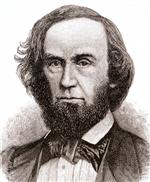
Missouri Governor Claiborne Jackson also realized he needed to set things in motion. On April 17th, the same day he had rejected Lincoln's call for volunteers, Jackson dispatched two representatives, Captain Colton Greene and Captain Basil Duke, to meet with CSA President Jefferson Davis in Montgomery, Alabama and present a letter written by Jackson requesting the arms they needed to seize the St. Louis Arsenal. [130]
Later in April Jackson received the following reply from President Jefferson Davis, Confederate States of America: [131]
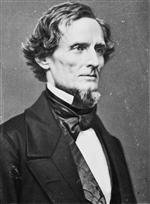
SIR: I have the honor to acknowledge yours of the 17th instant, borne by Captains Green and Duke, and have most cordially welcomed the fraternal assurances it brings . . . After learning as well as I could from the gentlemen accredited to me what was most needful for the attack on the arsenal, I have directed that Captains Green and Duke should be furnished with two 12-pounder howitzers and two 32-pounder guns, with the proper ammunition for each. These, from the commanding hills, will be effective, both against the garrison and to breach the inclosing walls of the place. I concur with you as to the great importance of capturing the arsenal and securing its supplies . . . We look anxiously and hopefully for the day when the star of Missouri shall be added to the constellation of the Confederate States of America.
Jackson also decided to call the Missouri General Assembly into session in Jefferson City on May 2nd “for the purpose of enacting such measures as might be deemed necessary and proper for the more perfect organization and equipment of the militia, and to raise the money, and provide such other means as might be required to place the State in a proper attitude of defence.” Jackson felt it was time to mobilize his military and ordered the State Militia to assemble in their respective districts on May 6th. [132]
Frank Blair knew that there were more than enough volunteers in St. Louis alone to fill Missouri's quota. But he also knew that Missouri Governor Jackson would never accept any volunteers into service for the Union. On April 17th, Frank Blair sent a message to U. S. Secretary of War Simon Cameron requesting authorization to muster independent companies and regiments as volunteers into Federal service. He also warned that the secessionists were planning to occupy the high ground above the arsenal, which would make defending the arsenal very difficult. Part of Frank Blair's message to Cameron: [133]
Our Governor will not meet your requisition for volunteers. Will you accept independent companies and regiments from Missouri? If so, please order Captain Lyon to muster them into service.

In large part due to Frank Blair’s lobbying, Captain Nathaniel Lyon would receive the following telegram from Washington on April 30th:[134]
SIR: The President of the United States directs that you enroll in the military service of the United States [volunteers] ten thousand in number, for the purpose of maintaining the authority of the United States; for the protection of the peaceable inhabitants of Missouri; and you will, if deemed necessary for that purpose by yourself and by Messrs. Oliver T. Filly, John How, James O. Broadhead, Samuel T. Glover, J. Wilzie, and Francis P. Blair, jr., proclaim martial law in the city of Saint Louis.
The additional force hereby authorized shall be discharged, in part or in whole, if enlisted, as soon as it appears to you and the gentlemen above named that there is no danger of an attempt on the part of the enemies of the Government to take military possession of the city of Saint Louis, or put the city in the control of a combination against the Government of the United States; and whilst such additional force remains in the service the same shall be governed by the Rules and Articles of War, and such special regulations as you may prescribe. I shall like the force heretofore directed to be enrolled to be under your command.
The arms and other military stores in the Saint Louis Arsenal not needed for the forces of the United States in Missouri must be removed to Springfield, or some other safe place of deposit in the State of Illinois, as speedily as practicable, by the ordnance officer in charge at Saint Louis.
[Indorsements.]
It is revolutionary times, and therefore I do not object to the irregularity of this.
W. S. [William Seward]
Approved, April 30, 1861.
A. LINCOLN.
Colonel Thomas will make this order.
SIMON CAMERON, Secretary of War.
Robert J. Rombauer, one of four Hungarian-American brothers to serve the Union during the war, had the following to say about the first Missouri volunteers for the Union that were mustered in at the St. Louis Arsenal: [135]
It will remain forever a memorable fact that within ten days from April 21, when the order authorizing the muster-in of troops was issued to Captain Lyon. to the first day of May, five Regiments, not of previously organized militia, but of actual Volunteers, one Battalion of Artillery and one Company of Pioneers, and within ten days more to May 11, five more Regiments of Reserves did enter the United States service in a Slave State. Such results were only possible under the favorable circumstances which shaped the disposition of the Union men of St. Louis.